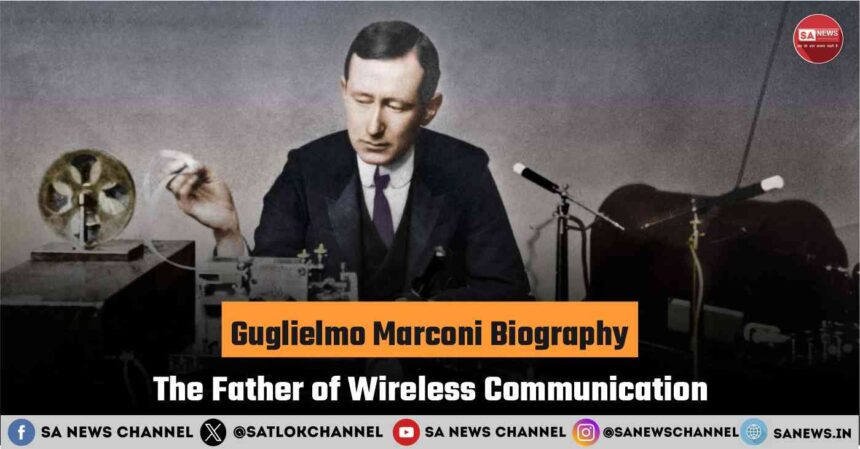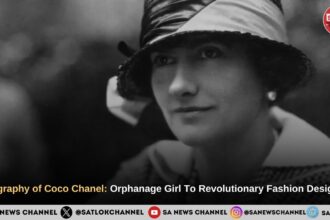Guglielmo Marconi, born on April 25, 1874, in Bologna, Italy, was destined to change the world of communication. He hailed from an affluent family, his father, Giuseppe Marconi, was an Italian aristocrat, and his mother, Annie Jameson, was of Irish descent from a prominent family of distillers. Growing up, Marconi exhibited remarkable curiosity and intelligence. Despite limited formal schooling, he developed an early fascination with electricity and physics. This curiosity laid the foundation for his groundbreaking contributions to wireless communication.
- Inspiration from Electromagnetic Theory
- Early Experiments in Italy
- Move to England and Securing the Patent
- Formation of the Marconi Company
- Transatlantic Wireless Breakthrough
- Impact on Maritime Safety and Communication
- Contributions During World War I
- Global Expansion and Broadcasting Innovation
- Recognition, Honors, and Personal Life
- Challenges and Scientific Criticism
- Legacy and Modern Influence
- Marconi as a Visionary Inventor
- Guglielmo Marconi’s Enduring Legacy
- Spiritual Perspective: Marconi’s Life: Inspiration Beyond Science
- Frequently Asked Questions About Guglielmo Marconi
Inspiration from Electromagnetic Theory
Marconi’s fascination with wireless communication was sparked by the work of Heinrich Hertz, who in the 1880s demonstrated the existence of electromagnetic waves, confirming James Clerk Maxwell’s theoretical predictions. Inspired by these discoveries, Marconi began experimenting with wireless telegraphy as a teenager, attempting to transmit Morse code signals without wires. These early experiments were the first steps toward the global communication revolution he would later lead.
Early Experiments in Italy
In 1894, Marconi began experimenting with wireless transmission at home. By 1895, he achieved a major milestone by successfully sending signals over approximately 1.5 miles (2.4 km) across the hills near his family estate. Though simple, these experiments were crucial for understanding signal propagation and antenna design. They marked the beginning of a lifelong pursuit of wireless communication.
Move to England and Securing the Patent
Facing limited recognition in Italy, Marconi moved to London in 1896, seeking funding and support. His persistence paid off when he was granted a British patent for wireless telegraphy on June 2, 1896. This patent covered the use of electromagnetic waves for communication and established Marconi as a leading innovator in the field. This milestone laid the groundwork for his commercial ventures and global impact.
Formation of the Marconi Company
Following his patent, Marconi established the Wireless Telegraph & Signal Company, later renamed the Marconi Company, to commercialize his invention. He began demonstrating wireless signals over longer distances, and in 1899 successfully transmitted the first signal across the English Channel, connecting England and France. This achievement showcased the practicality of wireless communication for maritime and international purposes.
Transatlantic Wireless Breakthrough
Marconi’s most significant achievement came in 1901 when he transmitted the first transatlantic wireless signal from Poldhu, Cornwall, England, to St. John’s, Newfoundland, Canada, covering over 2,000 miles (3,200 km). Receiving the Morse code letter “S” in Newfoundland demonstrated the feasibility of long-distance wireless communication and cemented Marconi’s status as the Wireless Communication Pioneer.
Impact on Maritime Safety and Communication
Marconi’s wireless technology revolutionized maritime communication. Ships at sea could now send distress signals and coordinate navigation without relying on physical cables. The Titanic disaster of 1912 highlighted the life-saving potential of his invention, as wireless systems enabled the transmission of SOS signals, ensuring timely rescue. His work fundamentally improved maritime safety and changed global communication practices.
Contributions During World War I
During World War I, Marconi’s wireless systems were vital for military operations, particularly in naval communication and intelligence. His technology enabled secure, long-distance communication, proving indispensable for strategic planning. In recognition of his pioneering work, Marconi was awarded the Nobel Prize in Physics in 1909, shared with Karl Ferdinand Braun, for their contributions to wireless telegraphy.
Global Expansion and Broadcasting Innovation
Marconi expanded his technology globally, establishing wireless stations across Europe, North America, and beyond. He experimented with shortwave transmission, enabling long-distance communication using smaller antennas, a precursor to modern radio and global broadcasting networks. In the 1920s and 1930s, Marconi promoted public radio, founding stations for news, education, and entertainment.
Also Read: Vint Cerf: Architect of the Internet and TCP/IP Pioneer
By making wireless communication accessible to the public, he reshaped society and media consumption patterns.
Recognition, Honors, and Personal Life
Marconi received numerous accolades, including the Order of Merit in the United Kingdom and appointments as Senator in Italy, alongside honorary doctorates from prestigious universities. He married Beatrice O’Brien in 1905, and the couple had three daughters. Even with global fame, Marconi remained deeply committed to scientific exploration, conducting experiments at his estates in Italy and England, and maintaining collaboration with leading scientists worldwide.
Challenges and Scientific Criticism
Despite his acclaim, Marconi faced skepticism from parts of the scientific community. Some contemporaries questioned the originality or practicality of his wireless systems. However, his repeated successful demonstrations, commercial ventures, and practical applications of wireless technology eventually silenced critics, establishing Marconi as a universally recognized inventor and innovator.
Legacy and Modern Influence
Marconi passed away on July 20, 1937, in Rome, Italy, at the age of 63. His work laid the foundation for modern radio, television, radar, satellite communication, and wireless networks, including mobile telephony and the internet. The world’s reliance on wireless technology today is a direct result of Marconi’s innovations. He demonstrated how human curiosity, experimentation, and entrepreneurial vision could reshape civilization.
Marconi as a Visionary Inventor
Marconi’s life exemplifies visionary thinking and perseverance. By recognizing the potential of electromagnetic waves and applying practical experimentation, he revolutionized communication. From transmitting simple signals across hills in Italy to enabling transatlantic communication, Marconi’s achievements transformed society and inspired generations of scientists and inventors. His contributions serve as a testament to the power of human ingenuity.
Guglielmo Marconi’s Enduring Legacy
Guglielmo Marconi’s life and work remain a cornerstone in the history of wireless communication. His inventions not only revolutionized communication technology but also improved global connectivity and safety. As the father of wireless communication, his legacy continues to influence modern society, from radios and televisions to smartphones and satellite networks. Marconi’s story is a timeless reminder that innovation, vision, and determination can change the world, leaving an enduring impact for generations to come.
Spiritual Perspective: Marconi’s Life: Inspiration Beyond Science
While Guglielmo Marconi is celebrated for his groundbreaking contributions to wireless communication, his life also offers deeper lessons about vision, perseverance, and using knowledge for the benefit of humanity. Marconi’s curiosity and dedication remind us that human intellect, when combined with patience and focus, can bring transformative changes to society.
From a spiritual perspective, Marconi’s work illustrates the importance of seeking knowledge not just for personal gain but for the greater good. His inventions improved communication, enhanced safety, and connected people across continents. Similarly, spiritual knowledge, as explained by the Chyren Saint Rampal Ji Maharaj in His book “Way of Living,” teaches that true progress in life comes when knowledge is used to uplift humanity and align one’s actions with divine wisdom.
For readers seeking guidance beyond material inventions and scientific achievements, the book “Way of Living” by Saint Rampal Ji Maharaj offers profound insights into life, purpose, and devotion. Just as Marconi’s inventions connected the world physically, Saint Rampal Ji Maharaj guides humans toward spiritual connection with the Supreme God, showing a path to eternal peace and fulfillment.
By reflecting on Marconi’s dedication and combining it with spiritual understanding, we can learn a balanced approach: striving for excellence in worldly knowledge while cultivating devotion and moral responsibility. This integration of intellect and spirituality leads to a meaningful life, helping humanity progress both materially and spiritually.To read the book download the free app Sant Rampal Ji Maharaj from the play store.
Frequently Asked Questions About Guglielmo Marconi
1. Who was Guglielmo Marconi?
Guglielmo Marconi (1874–1937) was an Italian inventor and electrical engineer, widely known as the father of wireless communication. He pioneered long-distance radio transmission, founded the Marconi Company, and laid the foundation for modern wireless technology, including radio, television, and satellite communication.
2. What were Marconi’s major achievements?
Marconi’s major achievements include:
- Transmitting the first wireless signals over short distances in 1895.
- Sending the first wireless signal across the English Channel in 1899.
- Successfully transmitting the first transatlantic wireless signal from England to Newfoundland in 1901.
- Establishing a global wireless network and promoting radio broadcasting.
3. How did Marconi impact maritime safety?
Marconi’s wireless technology revolutionized maritime communication. Ships could send distress signals without relying on physical cables. The Titanic disaster in 1912 highlighted the importance of his invention, as wireless SOS signals enabled timely rescue operations, saving many lives.
4. What recognition did Marconi receive for his work?
Marconi received numerous honors, including:
- Nobel Prize in Physics (1909), shared with Karl Ferdinand Braun.
- Order of Merit (UK).
- Appointment as Senator in Italy.
- Honorary doctorates from several universities worldwide.
5. How can Marconi’s life inspire spiritual growth?
Marconi’s dedication, curiosity, and use of knowledge for humanity illustrate that true success comes from using one’s skills for the greater good. For readers seeking spiritual guidance, “Way of Living” by Saint Rampal Ji Maharaj offers insights on connecting knowledge, devotion, and moral responsibility to lead a meaningful life.









